Introduction¶
约 1259 个字 11 张图片 预计阅读时间 4 分钟
Abstract
- Database Systems
- Database Applications
- Purpose of Database Systems
- View of Data
- Data Models
- Database Languages
- Database Design
- Database Engine
- Database Users and Administrators
- History of Database Systems
Database Systems¶
DBMS (Database Management System)

Purpose of Database Systems¶
Database systems offer solutions to all the below problems.
- data redundancy ( 数据冗余 ) and inconsistency
- data isolation ( 数据孤立,数据孤岛 )
- difficulty in accessing data
-
Integrity problems ( 完整性问题 )
- 完整的约束条件被藏在数据和代码中,而不是显式地声明。 e.g. "account balance \(\geq\) 1"
-
Atomicity problems ( 原子性问题 )
- Failures may leave database in an inconsistent state with partial updates carried out e.g. 从 A 账户转账到 B, 我们必须保证 A 转出 B 转入这两件事同时进行,不能被打断。
-
Concurrent access anomalies ( 并发访问异常 )
- Uncontrolled concurrent accesses can lead to inconsistencies
Example
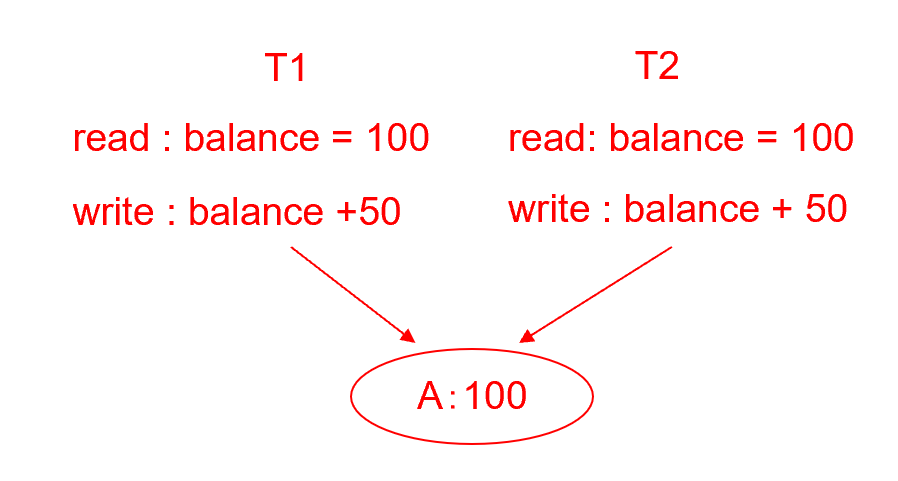
-
Security problems
- Authentication ( 认证 ), Priviledge ( 权限 ), Audit ( 审计 )
Characteristics of Databases¶
- data persistence ( 数据持久性 )
- convenience in accessing data ( 数据访问便利性 )
- data integrity( 数据完整性 )
- concurrency control for multiple user ( 多用户并发控制 )
- failure recovery ( 故障恢复 )
- security control ( 安全控制 )
View of Data¶
Three-level abstraction of databases

- physical level: 物理中如何保存、实现(如磁盘)
- logical level: 数据库中存储什么数据?数据之间的关系?
- view level: 不同人看到不同的他们所需要的数据
Advantages:
- Hide the complexities
- Enhance the adaptation to changes
硬件环境变化 (physical level), 可以通过调整逻辑关系和映射来适应新的硬件环境。
逻辑环境变化 (logic level), 可以通过 view 和 logic 的映射使得 view 尽量少变化。
Schema and Instance¶
Similar to types and variables in programming languages.
- Schema ( 模式 )– the logical structure of the database (physical/logical)
- Instance ( 实例 ) – the actual content of the database at a particular point in time
Data Independence¶
- Physical Data Independence ( 物理数据独立性 ) – the ability to modify the physical schema without changing the logical schema
- Logical Data Independence ( 逻辑数据独立性 ) - the ability to modify the logical schema without changing the user view schema
映射修改,但不用修改 schema.
Data Models¶
Data models is a collection of tools for describing data, data relationships, data semantics, data constraints.
- Relational model( 关系模型 )
(表格)数据库系统层面 - Entity-Relationship( 实体 - 联系 ) data model
需求分析层面 - Object-based data models
- Object-oriented ( 面向对象数据模型 )
- Object-relational ( 对象 - 关系模型模型 )
- Semistructured data model (XML)( 半结构化数据模型 )
- Other older models:
- Network model ( 网状模型 )
- Hierarchical model( 层次模型 )
Relational Model

12 tuples, 4 attributes.
Datahase Languages¶
Data Definition Language (DDL, 数据定义语言 ) ¶
Example

C 语言里的 struct 经过编译后全部变为了代码(有一张符号表)但数据库里不会。
Data dictionary contains metadata ( 元数据,i.e. data about data)
- DDL compiler generates a set of table templates stored in a data dictionary ( 数据字典 )
- Database schema
- Integrity constraints ( 完整性约束 ) Primary key (ID uniquely identifies instructors, 主键) Referential integrity (references constraint in SQL, 参照完整性) e.g. dept_name value in any instructor tuple must appear in department relation
- Authorization ( 权限 )
Data Manipulation Language (DML, 数据操作语言 ) ¶
Two classes of languages
- Procedural ( 过程式 )– user specifies what data is required and how to get those data e.g. C
- Declarative (nonprocedural,陈述式,非过程式 ) – user specifies what data is required without specifying how to get those data e.g. SQL
SQL is the most widely used query language
SQL Query Language¶

Database Access from Application Program¶
数据库必须由过程式语言编写。
Application programs generally access databases through one of * Language extensions to allow embedded SQL e.g. 通过预处理器,将 select 语句识别出来,翻译成 C 语言的函数调用。 * API (Application program interface) e.g. ODBC/JDBC which allow SQL queries to be sent to a database.
Database Design¶
-
Entity Relationship Model ( 实体 - 联系模型 )
一对一/一对多/多对一/多对多
图是中立的,可以用关系数据库 / 面向对象数据库实现
-
Normalization Theory ( 规范化理论 )
Formalize what designs are bad, and test for themExample
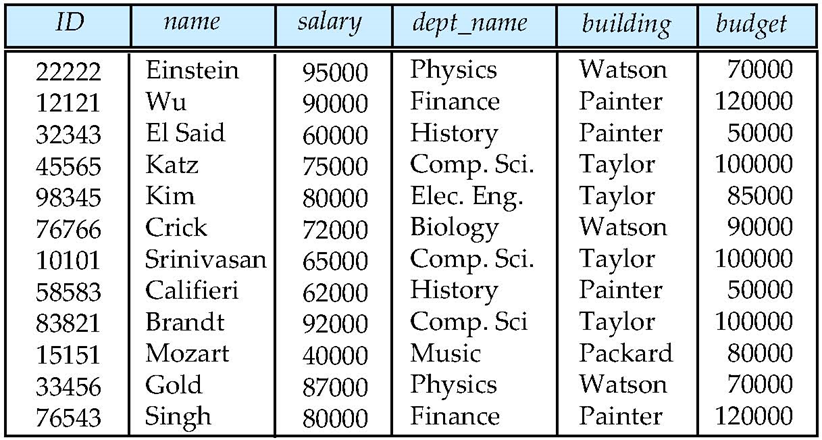
这个表存在冗余 , department 有重复,应该拆分为两个表(前四列和后三列)
Database Enginee¶
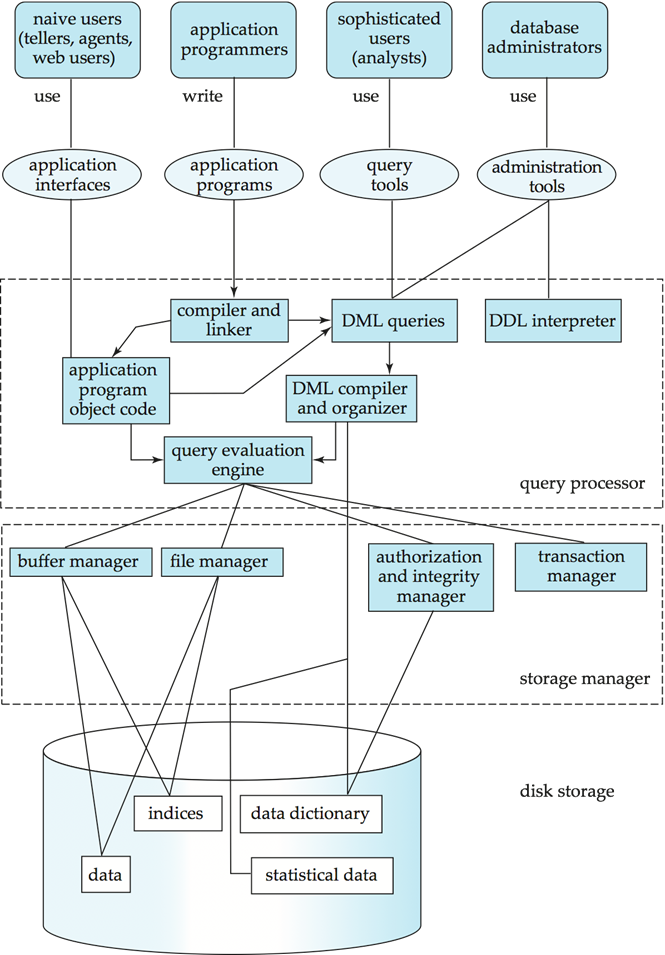
- The storage manager,
- The query processor component,
- The transaction management component.
Storage Manager¶
为了数据持久化,放在硬盘里,但数据处理要进入内存,这之间存在数据鸿沟。
按块访问内存 (4k/16k), 缓冲管理。
- File manager
- Buffer manager
- Authorization and integrity manager
- Transaction manager
数据库里放的是
- data files 真正的数据
- data dictionary 放的是 metadata
- statistical data 用于数据库的查询处理
- indices
Query Processor¶
The query processor components include:
- DDL interpreter -- interprets DDL statements and records the definitions in the data dictionary.
- DML compiler -- translates DML statements in a query language into an evaluation plan consisting of low-level instructions that the query evaluation engine understands.
- The DML compiler performs query optimization ( 查询优化 ); that is, it picks the lowest cost evaluation plan from among the various alternatives.
执行计划会根据统计数据的改变而改变。
- The DML compiler performs query optimization ( 查询优化 ); that is, it picks the lowest cost evaluation plan from among the various alternatives.
- Query evaluation engine -- executes low-level instructions generated by the DML compiler.
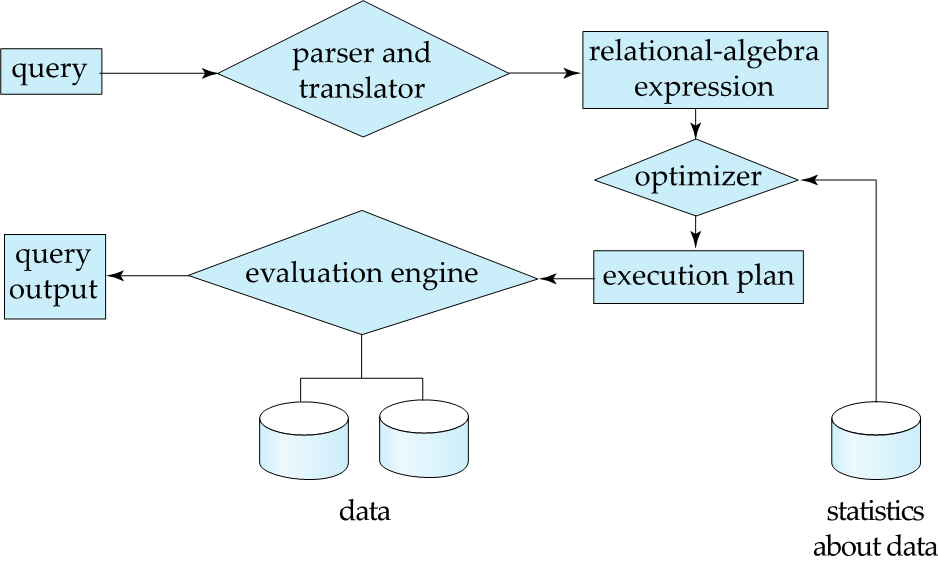
- Parsing and translation
- Optimization
- Evaluation
Transaction Management ( 事务管理 ) ¶
银行转账,A 转账到 B, A 余额减掉 B 余额加上。 要有隔离性,延迟写回
- Recover Manager
ensures that the database remains in a consistent (correct) state despite system failures (e.g. power failures and operating system crashes) and transaction failures.
日志,防止写回数据库时出现断电或者崩溃。 - Concurrency-control manager
controls the interaction among the concurrent transactions, to ensure the consistency of the database.
Database Users¶
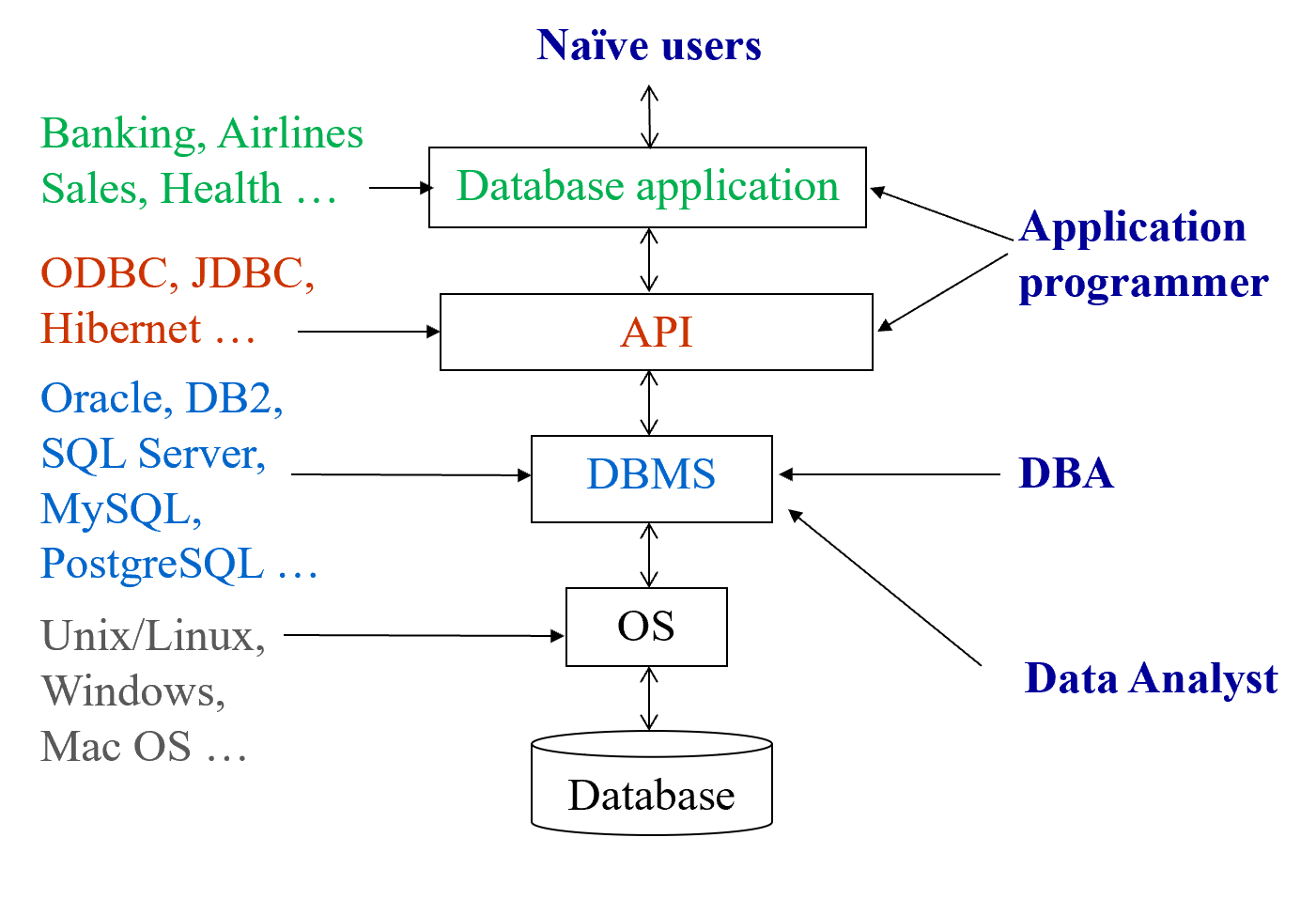
- Database Administrator (DBA)
数据库管理员,要做定义模式,数据库调谐,故障时恢复(备份)等工作。
老师:我不看好!
History¶
- 1973 Turing Award: Charles W. Bachman
father of databases - 1981 Turing Award: Edgar F. Codd
- 1998 Turing Award: Jim Gray
- 2014 Turing Award: Michael Stonebraker